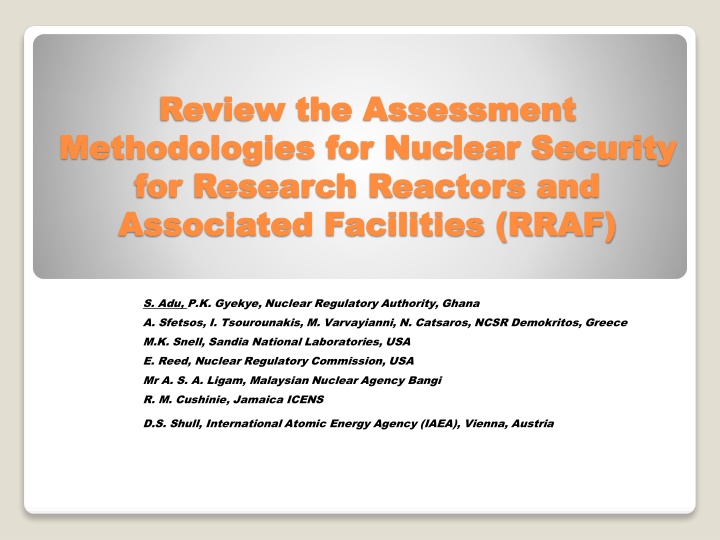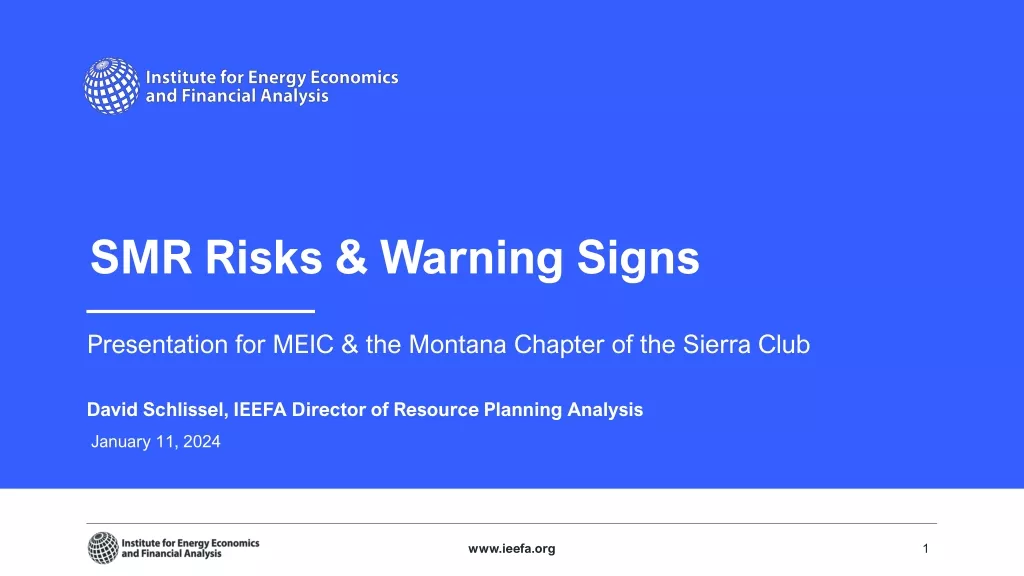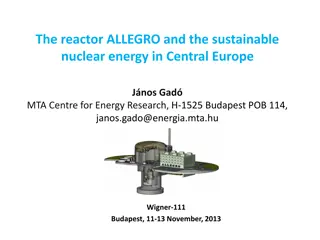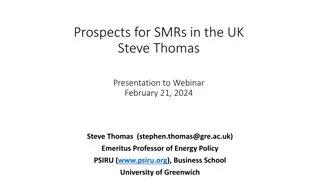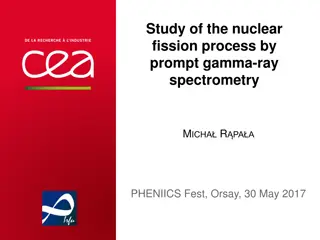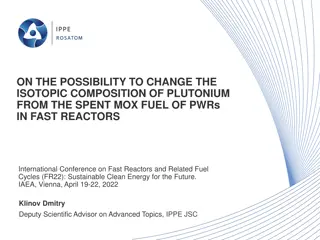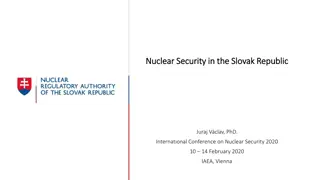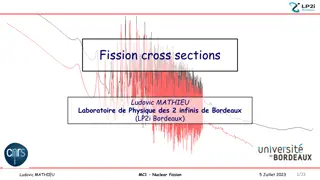Comprehensive Review of Methodologies for Nuclear Security in Research Reactors and Facilities
This review assesses methodologies for nuclear security in Research Reactors and Associated Facilities (RRAF). It focuses on applying a performance-based framework to evaluate the protection of nuclear materials and facilities. A case study on the Vulnerability of Integrated Security Analysis methodology at the Hypothetical Atomic Research Institute (HARI) is presented. The methodology involves qualitative and quantitative approaches to assess the effectiveness of protection measures. Analysis results prioritize risks within the HARI facility, highlighting potential targets for sabotage.
Download Presentation

Please find below an Image/Link to download the presentation.
The content on the website is provided AS IS for your information and personal use only. It may not be sold, licensed, or shared on other websites without obtaining consent from the author.If you encounter any issues during the download, it is possible that the publisher has removed the file from their server.
You are allowed to download the files provided on this website for personal or commercial use, subject to the condition that they are used lawfully. All files are the property of their respective owners.
The content on the website is provided AS IS for your information and personal use only. It may not be sold, licensed, or shared on other websites without obtaining consent from the author.
E N D
Presentation Transcript
Review the Assessment Review the Assessment Methodologies for Nuclear Security Methodologies for Nuclear Security for Research Reactors and for Research Reactors and Associated Facilities (RRAF) Associated Facilities (RRAF) S. Adu, P.K. Gyekye, Nuclear Regulatory Authority, Ghana A. Sfetsos, I. Tsourounakis, M. Varvayianni, N. Catsaros, NCSR Demokritos, Greece M.K. Snell, Sandia National Laboratories, USA E. Reed, Nuclear Regulatory Commission, USA Mr A. S. A. Ligam, Malaysian Nuclear Agency Bangi R. M. Cushinie, Jamaica ICENS D.S. Shull, International Atomic Energy Agency (IAEA), Vienna, Austria
Objective of CRP J02006 Objective of CRP J02006 Task 1 Task 1 Apply performance-based methodological framework in a systematic, structured, appropriately transparent manner for RRAFs. the NUSAM CRP results which are a comprehensive and The framework will be used to assess the PPS of nuclear and other radioactive materials, as well as associated facilities and activities within regulatory control. To provide an environment for the sharing and transfer of knowledge and experience, guidance on, and a practical example in assessing the PP of RRAFs. and to provide
Application to HARI Application to HARI This case upon Vulnerability of Integrated Security Analysis methodology which will qualitative results but with substitution values can quantitative results. study focuses use of the the (VISA) approach, produce of be numerical used for The case study is based on the Hypothetical Atomic Research Institute (HARI) Project being developed by IAEA HARI has 10 MW(th) research reactor, a radioisotope production facility, a low-enriched uranium fuel fabrication facility, a gamma irradiation facility, and a waste treatment and storage facility.
Methodology Model and Implementation Model and Implementation For the purposes of this paper only a VISA analysis is presented. VISA tool is using qualitatively or quantitatively approach to assess effectiveness of PP measures for the protection of NM/RMs, associated facilities and associated activities against unauthorized removal or sabotage. For this study, the qualitative approach will be demonstrated. This method identifies strengths as well as areas for improvement. It can be used to validate security plans and procedures, planned changes or upgrades, assess the types of systems needed to the prevention of, protection from, mitigation of, and response to a defined security incident.
ANALYSIS OF THE RESULTS ANALYSIS OF THE RESULTS The analysis was based on the HARI description. Using from the CRP Task 2, Risk Prioritization Scheme, Radioisotopes Production Filter Waste (RPFW) was identified as the most attractive dispersal target for sabotage within the HARI facility. the information Ranking the The CRP Task 2 Risk Prioritization results is shown in Figure 1 . Ranking FIG. 1 HARI RELATIVE RISK RANKING ASSESSMENT
Analysis of Results Analysis of Results Scenarios Scenarios RPF Waste Filters - Baseline (Sabotage) Using a step ladder, the four person adversary team climbs over the LAA fence and the PA alarmed fence on west side of the facility. The adversaries move to the northeast corner of the Radioisotope Production Facility (RPF) building where two adversaries place an explosive charge on the re- enforced concrete wall. They retreat, taking safe cover for detonation of the explosives. Following the explosive, they return and clear the rubble and enter Room B where contaminated ventilation system waste filters are stored. They removed the waste filters from their original positions and carry them just outside the RPF building and using explosives, they detonate the filter to produce a radioactive dispersal. Table 1 illustrates the scenario timeline of events.
Analysis of Results Analysis of Results TABLE 1. VISA TIMELINE RESULTS - BASELINE SABOTAGE Sabotage Base Case Sabotage Base Case Threat: 4 adversaries + active nonviolent insider Threat: 4 adversaries + active nonviolent insider Step Description Target: Ventilation System Waste Filters PS Step Step PA PI PN Step Score Step time Sec Cuml Time Sec RF time Sec Using a step ladder to climb over the LAA fence on west side (4 adversaries) 4 X 12s. No sensors or CCTV coverage. Table I.11 NUSAM page 83 Using the step ladder to climb over the PA alarmed fence on west side (4 adversaries) 4 X 12s. Defeat of alarmed fence. Table I.11 NUSAM page 83 Adversaries move from the PA fence to the RPF building (175m) - no CCTV coverage and random guard patrol is very low sensing and assessment (ref page 100 NUSAM Table IX.11) Two adversaries place explosive charge on the re-enforce concrete wall (15 sec). They retreat taking safe cover (15 sec) for detonation. 1 1 48 VL VL VL H VL 2 2 48 VL VH VL H VL 3 3 70 VL VL VL H VL 4 4 30 VL VL VL H VL First explosive charge is detonated (assuming 1 stage explosive for concrete structure 120s, 2 stages eliminate reinforced bar 54s). Table I.9 page 82 NUSAM. Building pressure differential alarm activated. CAS dispatches response. 5 5 174 174 450 VH VH VL H VL Two adversaries entered the room B where ventilation system waste filters are kept. (Assessment by CAS guard at the reactor building guard- VH if they see it) 6 6 15 189 435 M VH VL H VL Two adversaries setup explosive charge outside of the building and at the same time, 2 adversaries enter the building. Filters are in open storage in the room. The Adversaries remove 12 filters (10kg each) from their storage positions and carry them just outside the RPF building. The waste filters are stacked up over the explosive charges. Total activity of 7743 TBq. Two adversaries make six trips each (2 waste filters) for 10s each trip. 7 7 120 309 315 VH VH VL H VL Adversaries retreat and detonate the filters explosive with remote device. 8 8 30 339 285 VH VH VL H VL VL SYSTEM EFFECTIVENESS The total Response Time is assumed to the 450 seconds after detection. From the results, the adversaries achieved their mission at 339 seconds after detection which is 285 seconds prior to response arrival, therefore interruption is Very Low. The probability of neutralization is assumed High since there are 8-10 responders to 4 adversaries. The overall system effectiveness is considered Very Low.
Analysis of Results Analysis of Results RPF Waste Filters - Upgrade (Sabotage) The same scenario as illustrated in slide 6 was analysed with the proposed upgrades of adding a sensor alarm along the protected area perimeter to reduce the likelihood of using a ladder to avoid sensing by the alarmed fence. The added sensor provides sensing between the outer and inner PA fence. Additionally filter locking cages were installed in filter room to increase delay times for removal. Table 2 illustrates the scenario timeline of events.
Analysis of Results Analysis of Results TABLE 2. VISA TIMELINE RESULTS - UPGRADE SABOTAGE Sabotage Upgrade Case Sabotage Upgrade Case Threat: 4 adversaries + active nonviolent insider Threat: 4 adversaries + active nonviolent insider Target: Ventilation System Waste Filters Step Step Step Score Step time Cuml Time Sec Step Description PS PA PI PN RF time Sec Sec Using a step ladder to jump over the LAA fence on west side (4 adversaries) 4 X 12s. New sensor system installed between LAA and PA fence to detect adversaries attempting to bridge the PA. Detected at 12s. Table I.11 NUSAM page 83. CAS guard dispatch rover or command building guard to assess. 1 1 24 12 450 VH VH VH H H Using the step ladder to jump over the PA fence on west side (4 adversaries) 4 X 12s. Table I.11 NUSAM page 83 2 2 48 60 402 VH VH VH H H Adversaries move from the fence to the RPF building (175m) - no CCTV and random guard patrol very low (ref page 100 NUSAM Table IX.11) 3 3 70 130 332 VL VL VH H VL Two adversaries place explosive charge on the re-enforce concrete wall (15 sec). They retreat taking safe cover (15 sec) for detonation. 4 4 30 160 302 First explosive charge is detonated (assuming 1 stage explosive for concrete structure 120s, 2 stages eliminate reinforced bar 54s). Table I.9 page 82 NUSAM. Pressure differential alarm activated. The Critical Detection Point occurs in this step. 5 5 174 334 128 VH VH VH H H Two adversaries entered the room B where ventilation system filters are kept. Breaching delay time for new filter cages is 200s total. (Assessment by ACS CAS guard and guard at the reactor building guard- VH if they see it) Armed response arrives. 6 6 215 549 -87 M VH H H M Two adversaries setup explosive charge outside of the building and at the same time, 2 adversaries enter the building. Filters in open storage. They removed 12 filters (10kg each) from their original positions and carry them just outside the RIPF building. Filters stack up at charges. Total activity of waste filters is 7743 TBq. 2 adversaries carry 6 times each with 10s each time. 7 7 120 669 -207 VH VH VL H VL 8 8 30 699 -237 Adversaries retreat and detonate the filters explosive with remote device. VH VH VL H VL H SYSTEM EFFECTIVENESS
Analysis of Results Analysis of Results RPF Waste Filters - Upgrade (Sabotage) The modeled upgrades were effective from the point that detection (sensing and assessment) occurred between the Limited Access Area boundary and the protected area boundary. Additional significant delay was added to the adversary task time in the RFP filter storage room. Table 2 illustrates the major timeline of events for the upgrade. The total Response Time is assumed to be 450 seconds after detection. From the results, the adversary task time was increased to 669 seconds and the probability of interruption increased to Very High. The probability of neutralization is assumed High since there are 8-10 responders to 4 adversaries. The overall system effectiveness is considered High.
Analysis of Results Analysis of Results Scenarios Scenarios Research Reactor Facility Research Reactor Facility Base Case (Theft) Using a ladder, the four person adversary team climbs over the LAA fence and the PA alarmed fence on east side of the facility. The adversaries move to the auxiliary entrance to the Research Reactor building where three adversaries break the glass door and enter the building. They move to the reactor hall doors and breach them with explosives and remove the fresh fuel target quantity from the facility. The adversaries then move twenty-five fresh MOX fuel elements to the protected area perimeter and LAA boundary and load the material into a vehicle and depart the area. Table 3 illustrates the scenario timeline of events. Base Case (Theft)
Analysis of Results TABLE 3. VISA TIMELINE RESULTS - BASELINE THEFT THEFT Base Case THEFT Base Case Threat: 4 adversaries + active nonviolent insider Threat: 4 adversaries + active nonviolent insider Target: Fresh MOX Fuel Rods PA Step Step PS PI PN Step Score Step Description Step time Sec Cuml Time Sec RF time Sec 1 1 40 Using ladder to jump over the LAA fence on east side (4 adversaries) 4 X 10s VL VH VL H VL 2 2 40 Using ladder to jump over the PA fence on east side (4 adversaries) 4 X 10s Adversaries move from the fence to the auxiliary entrance to the reactor building (10m) - no CCTV and guard patrol very low VL VH VL H VL 3 3 10 VL VL VL H VL 2 adversaries break 2 glass doors with hammer- BMS defeated (no glass-break sensor). 3 adversaries moving inside the building and 1 remains outside the building 3 adversaries moving to stairway (20m) to the 3 floors up (20m) to SAS (35m). Assessment from interior camera but no sensors are installed. 4 4 15 VL VL VL H VL 5 5 35 VL VH VL H VL Adversaries breach the outer reactor hall door with 2 kg explosive. 30s from database plus 15s facility specific distance. Assessment from interior camera and the door sensor provides sensing. (The remaining outside adversary cuts the protected area perimeter fence and breaches LAA brick wall with explosives and returns to enter the building). 6 6 45 45 450 VH VH VH H H 7 7 35 80 415 Adversaries breach the inner reactor hall door using 2 kg explosive. 30s from database plus 5s facility specific distance. Assessment from interior camera and the door sensor provides sensing. The adversaries move to the fresh fuel storage room (5m - 2s) and breaches the hardened door (30s) with explosives. Door alarm and interior camera provide sensing and assessment. The Critical Detection Point occurs in this step. Adversaries taking 12 prototype MOX fuels. 45 kg per person. 4 adversaries carry total of 12 fuel element (3 each) to the entry door of the building. Adversaries exit the vault down stair to the front door (80m). VH VH VH H H 8 8 32 112 383 VH VH H H H 9 9 120 232 263 VH VH M H M 10 10 40 272 223 Adversaries move from the doors back to the perimeter wall (20m) VL VH L H VL 11 11 25 297 198 Load fuel in the truck VL VH VL H VL 12 12 45 342 153 Move back to the vault (100m) Adversaries taking 13 prototype MOX fuels. 45 kg per person. 4 adversaries carry total of 13 fuel element (3 or 4 each plus) to the entry door of the building. Adversaries exit the vault down stair to the front door (80m). VH VH VL H VL 13 13 120 462 33 VH VH VL H VL 14 14 40 502 -7 Adversaries move from the doors back to the perimeter wall (20m) VL VH VL H VL 15 15 35 537 -42 Load fuel in the truck and drive away VL M VL H VL SYSTEM EFFECTIVENESS SYSTEM EFFECTIVENESS H From the results, adversaries didn t managed to achieve their mission because Armed Response arrived before they drive away (Step 14). The probability of neutralization is assumed High since there are 8-10 responders to 4 adversaries. The overall system effectiveness is considered High.
GENERAL OBSERVATIONS Strengths 1/2 It can be used as a qualitative or quantitative approach It is easy to show the comparison of the task time and the response time It is more descriptive in terms of what are the key elements and activities of the overall assessment It is more flexible to go over the actions and the conducting time is less than a table top (TT) as described
GENERAL OBSERVATIONS Strengths 2/2 It is very useful tool for evaluating the PPS Counter measures can be easily identified at each specific step. It can easily calculate where there is a lack of PS, PA, PI and PN in a given PPS step or element. Can determine the Critical Detection Point (CDP) as compared to a TT It is useful for assessing the assumed response time
GENERAL OBSERVATIONS GENERAL OBSERVATIONS Weaknesses/Limitations It is subjective based on SME judgment It is a single path scenario too. It does not show multiple path as compare to other automated / computerized methods The results can be driven by a strong personality There is no detail on adversary and response force interaction activities as compare to TT methodologies Does not effectively assess command and control One person approach may not consider diverse views of other experts for input
CONCLUSION CONCLUSION The VISA proved adequate for the application of evaluating the effectiveness of the PPS at a RR facility. The following represents the conclusions of the working group team: VISA proved useful, however with the absence of site- specific performance tested data, analysis can be difficult. VISA protection elements (PS, PA, and PI) effectiveness for analyzed scenarios. provides a clear stakeholder understanding of Other analysis tools are recommended to address the VISA limitation to determine neutralization values.
